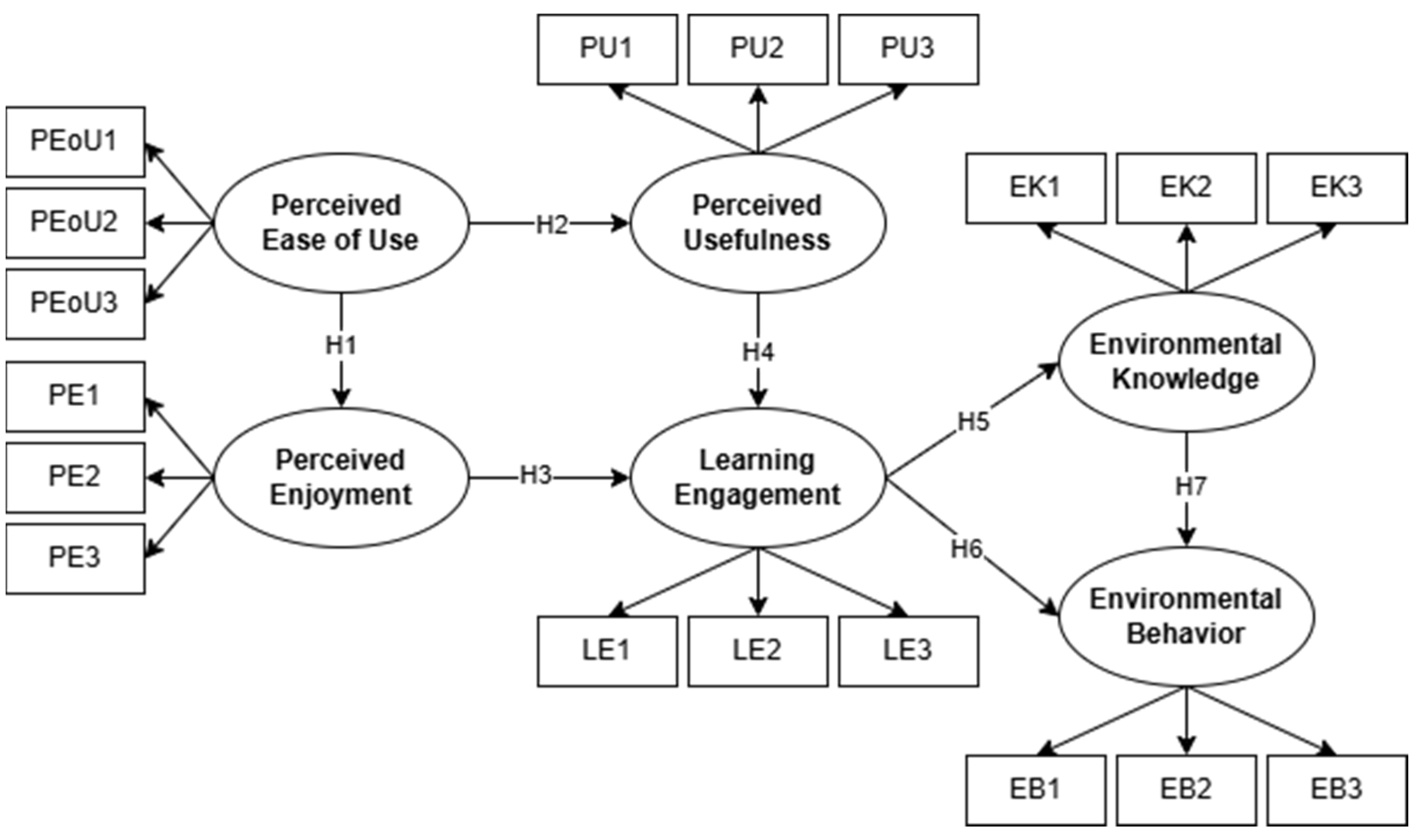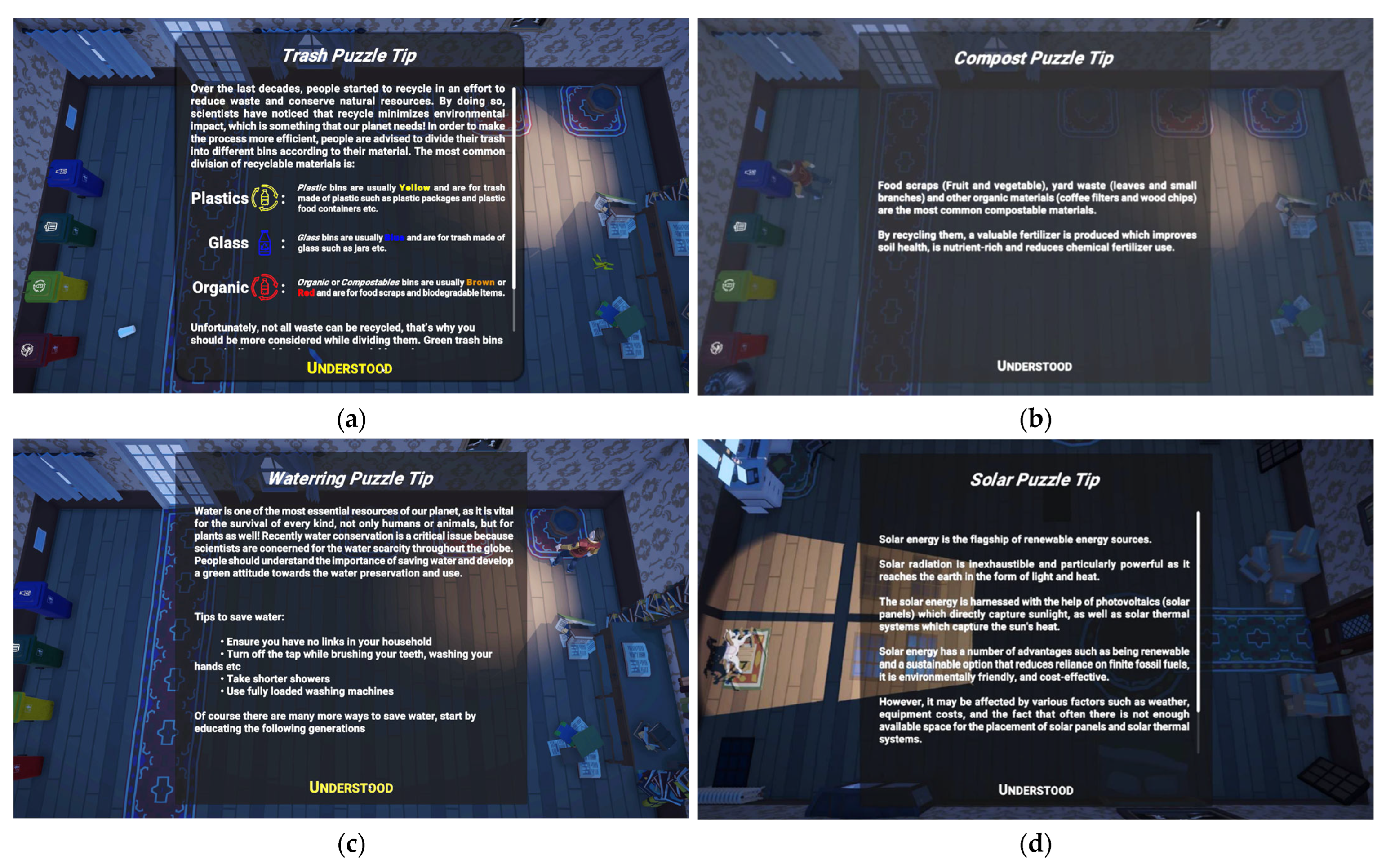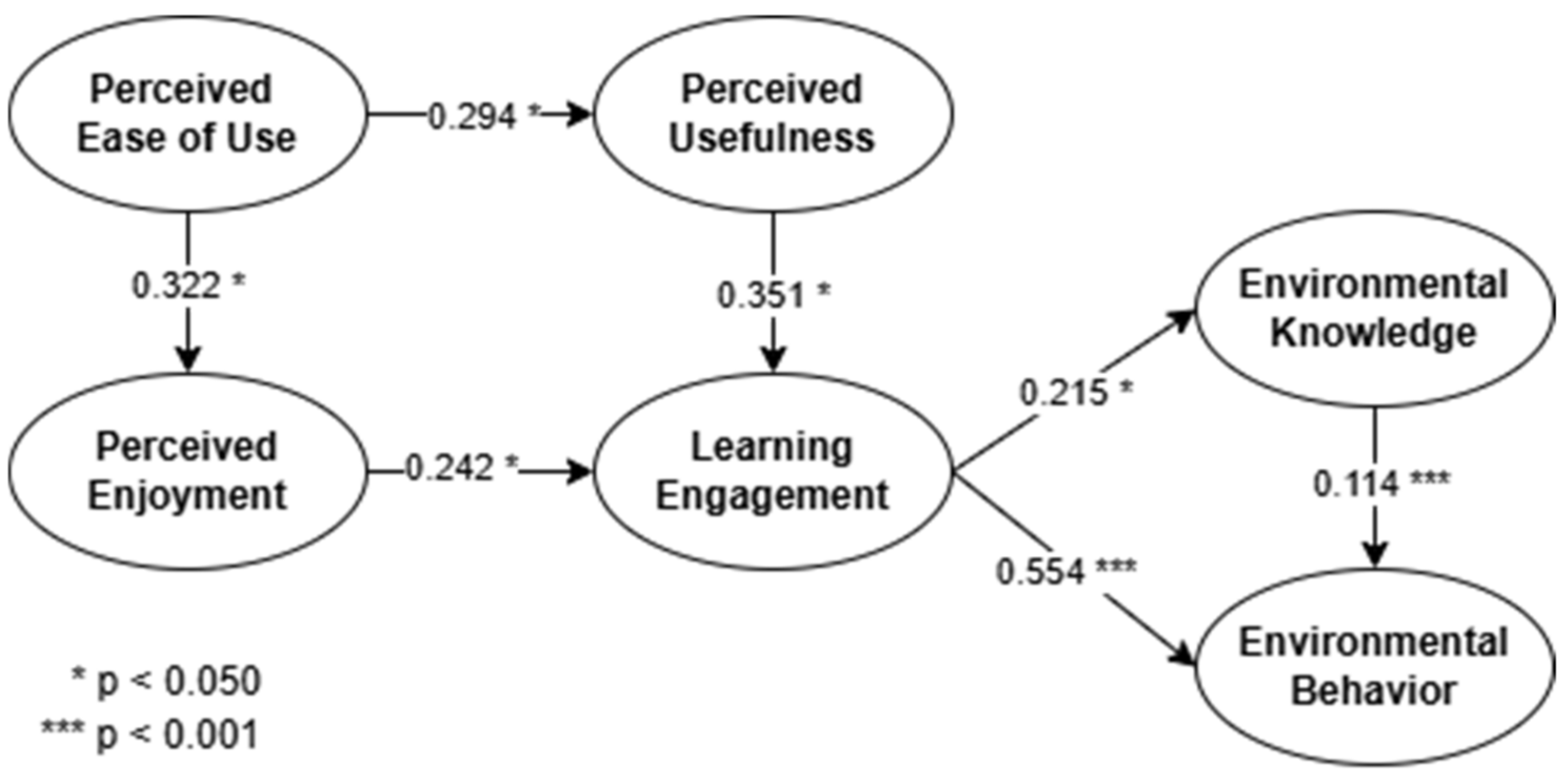Exploring the Acceptance and Impact of a Digital Escape Room Game for Environmental Education Using Structural Equation Modeling
Abstract
1. Introduction
2. Related Literature
3. System Overview
4. Materials and Methods
- Perceived Ease of Use (PEoU): It refers to the degree to which users believe that the game is easy to use. This variable is important for the acceptance of digital escape rooms. Three-dimensional environments need to have user-friendly interfaces in order to facilitate users during their navigation and interaction with game elements.
- Perceived Enjoyment (PE): This refers to the level of pleasure users experience while playing the game. This variable plays a crucial role in motivating users to engage further with the learning process and making it more enjoyable.
- Perceived Usefulness (PU): This refers to users’ perception of how beneficial the game is for environmental education. This variable is important for the adoption of digital escape rooms. Users who believe that the game is a valuable tool for learning about environmental issues are more motivated to use it. Moreover, the likelihood of withdrawing from the learning process is reduced.
- Learning Engagement (LE): This refers to the extent to which users engage with the game and the educational content. This variable plays a key role in the effectiveness of digital escape rooms for environmental education. In particular, the more engaged users are with the game, the more likely they are to explore the environmental material and apply it in real-life contexts.
- Environmental Knowledge (EK): This refers to the increase in users’ knowledge about environmental issues resulting from their interaction with the game. This variable is key in assessing the educational impact of digital escape rooms. Users who acquire a better understanding of environmental issues through the game are more prone to taking action to protect the environment.
- Environmental Behavior (EB): This refers to the changes in users’ behavior regarding environmental protection after playing the game. This variable is essential in evaluating the impact of digital escape rooms on users’ actions toward environmental conservation. Specifically, those who become more aware of environmental issues through the game may adopt more eco-friendly practices in their daily lives.

5. Results
6. Discussion
7. Conclusions
Author Contributions
Funding
Institutional Review Board Statement
Informed Consent Statement
Data Availability Statement
Conflicts of Interest
References
- Husin, A.; Helmi, H.; Nengsih, Y.K.; Rendana, M. Environmental education in schools: Sustainability and hope. Discov. Sustain. 2025, 6, 41. [Google Scholar] [CrossRef]
- Akinsemolu, A.A.; Onyeaka, H. The role of green education in achieving the sustainable development goals: A review. Renew. Sustain. Energy Rev. 2025, 210, 115239. [Google Scholar] [CrossRef]
- Krouska, A.; Kabassi, K.; Troussas, C.; Sgouropoulou, C. Personalizing Environmental Awareness through Smartphones Using AHP and PROMETHEE II. Future Internet 2022, 14, 66. [Google Scholar] [CrossRef]
- Hnatyuk, V.; Pshenychna, N.; Kara, S.; Kolodii, V.; Yaroshchuk, L. Education’s role in fostering environmental awareness and advancing sustainable development within a holistic framework. Multidiscip. Rev. 2024, 7, 2024spe012. [Google Scholar] [CrossRef]
- Yaseen, H.; Mohammad, A.S.; Ashal, N.; Abusaimeh, H.; Ali, A.; Sharabati, A.-A.A. The Impact of Adaptive Learning Technologies, Personalized Feedback, and Interactive AI Tools on Student Engagement: The Moderating Role of Digital Literacy. Sustainability 2025, 17, 1133. [Google Scholar] [CrossRef]
- Hajj-Hassan, M.; Chaker, R.; Cederqvist, A.-M. Environmental Education: A Systematic Review on the Use of Digital Tools for Fostering Sustainability Awareness. Sustainability 2024, 16, 3733. [Google Scholar] [CrossRef]
- Liu, J.; Zhang, X. Enhancing Environmental Awareness through Digital Tools in Environmental Education in China. Environ. Behav. Proc. J. 2024, 9, 123–129. [Google Scholar] [CrossRef]
- Brečka, P.; Valentová, M.; Tureková, I. Digital Technologies in Environmental Education. TEM J. 2022, 11, 726–730. [Google Scholar] [CrossRef]
- Duda, E. Technology-enhanced environmental learning: A practical guide to educational areas for urban educators. Environ. Res. Commun. 2024, 6, 121011. [Google Scholar] [CrossRef]
- Becker, L.; Dreesmann, D.C. Simulating Environmental Issues: New Digital Tools to Teach Biology In Silico. Sustainability 2023, 15, 14325. [Google Scholar] [CrossRef]
- Gkiolmas, A.; Dimakos, C.; Chalkidis, A.; Stoumpa, A. An environmental education project that measures particulate matter via an Arduino interface. Sustain. Futures 2020, 2, 100027. [Google Scholar] [CrossRef]
- Sidekerskienė, T.; Damaševičius, R. Out-of-the-Box Learning: Digital Escape Rooms as a Metaphor for Breaking Down Barriers in STEM Education. Sustainability 2023, 15, 7393. [Google Scholar] [CrossRef]
- Garwood, J. Escape to Learn! An Innovative Approach to Engage Students in Learning. J. Nurs. Educ. 2020, 59, 278–282. [Google Scholar] [CrossRef] [PubMed]
- Troussas, C.; Krouska, A.; Papakostas, C.; Mylonas, P.; Sgouropoulou, C. Utilizing Fuzzy Weights to Model Logical Reasoning in Digital Escape Rooms: Dynamic Difficulty Adjustment for Enhanced Digital Skill Development. In Proceedings of the 2024 19th International Workshop on Semantic and Social Media Adaptation & Personalization (SMAP), Athens, Greece, 21–22 November 2024; pp. 98–104. [Google Scholar] [CrossRef]
- Nasri, N.F.; Ahmad Zaidi, N.N.; Kamarudin, S.; Hanafi, M.; Nasir, Z.A. Digital Escape Room: Students’ Perceptions as an Educational Tool in Learning Reading Skills. Int. J. Educ. 2024, 16, 2. [Google Scholar] [CrossRef]
- Alabdulaziz, S. Escape rooms technology as a way of teaching mathematics to secondary school students. Educ. Inf. Technol. 2023, 28, 13459–13484. [Google Scholar] [CrossRef]
- Repetto, M.; Bianco Prevot, A.; Brizio, A.; Boldi, A.; Talarico, M.; Stanchi, S.; Palma, D.; Acquadro Maran, D. Digital Escape Rooms: A Resource for Environmental Education. Sustainability 2024, 16, 8525. [Google Scholar] [CrossRef]
- Lai, Y.-C.; Yang, J.-C. Exploring the Impact of Incorporating Digital Escape Room on Learners’ Performance and Motivation in Environmental Sustainability Education. In Proceedings of the International Conference on Computers in Education, Quezon City, Philippines, 25–29 November 2024. [Google Scholar] [CrossRef]
- Lathwesen, C.; Eilks, I. Can You Make it Back to Earth? A Digital Educational Escape Room for Secondary Chemistry Education to Explore Selected Principles of Green Chemistry. J. Chem. Educ. 2024, 101, 3193–3201. [Google Scholar] [CrossRef]
- Kim, C.; Na, H.; Zhang, N.; Bai, C. Escape rooms for education: A meta-analysis. Int. J. Instr. 2024, 17, 219–234. [Google Scholar] [CrossRef]
- Alieto, E.; Abequibel-Encarnacion, B.; Estigoy, E.; Balasa, K.; Eijansantos, A.; Torres-Toukoumidis, A. Teaching inside a digital classroom: A quantitative analysis of attitude, technological competence and access among teachers across subject disciplines. Heliyon 2024, 10, e24282. [Google Scholar] [CrossRef]
- Jongerling, J.; López-Pernas, S.; Saqr, M.; Vogelsmeier, L.V.D.E. Structural Equation Modeling with R for Education Scientists. In Learning Analytics Methods and Tutorials; Saqr, M., López-Pernas, S., Eds.; Springer: Cham, Switzerland, 2024. [Google Scholar] [CrossRef]
- Guerrero, G.; Sjöström, J. Critical scientific and environmental literacies: A systematic and critical review. Stud. Sci. Educ. 2024, 61, 41–87. [Google Scholar] [CrossRef]
- Munna, A.S.; Kalam, M.A. Teaching and learning process to enhance teaching effectiveness: A literature review. Int. J. Humanit. Innov. 2021, 4, 1–4. [Google Scholar] [CrossRef]
- Lee, C.-W.; Hung, H.-H. The Impact of Education on Consumers’ Eco-Friendly Shopping Habits towards Sustainable Purchases: Evidence from Indonesia and Taiwan. Sustainability 2024, 16, 8832. [Google Scholar] [CrossRef]
- Reid, A. Climate change education and research: Possibilities and potentials versus problems and perils? Environ. Educ. Res. 2019, 25, 767–790. [Google Scholar] [CrossRef]
- Şimşek, E.E. The Use of Augmented Reality-Supported Activities in Environmental Education for Early Childhood: A Quasi-Experimental Study. Sustainability 2024, 16, 10374. [Google Scholar] [CrossRef]
- Ladykova, T.I.; Sokolova, E.I.; Grebenshchikova, L.Y.; Sakhieva, R.G.; Lapidus, N.I.; Chereshneva, Y.V. Augmented reality in environmental education: A systematic review. Eurasia J. Math. Sci. Technol. Educ. 2024, 20, em2488. [Google Scholar] [CrossRef]
- Sharma, B.; Singh, N.P.; Mantri, A.; Gargrish, S.; Tuli, N.; Sharma, S. Save the Earth: Teaching Environment Studies using Augmented Reality. In Proceedings of the 2021 6th International Conference on Signal Processing, Computing and Control (ISPCC), Solan, India, 7–9 October 2021; pp. 336–339. [Google Scholar] [CrossRef]
- Chen, S.-Y. To explore the impact of augmented reality digital picture books in environmental education courses on environmental attitudes and environmental behaviors of children from different cultures. Front. Psychol. 2022, 13, 1063659. [Google Scholar] [CrossRef]
- Dudok, F.; Pigniczki-Kovács, E. Education for Sustainability through Gamification. Acta Cult. Paedagog. 2024, 3, 61–74. [Google Scholar] [CrossRef]
- Padilla Piernas, J.M.; Parra Meroño, M.C.; Flores Asenjo, M.P. Virtual Escape Rooms: A gamification tool to enhance motivation in distance education. RIED-Rev. Iberoamericana Educ. Dist. 2024, 27, 1. [Google Scholar] [CrossRef]
- Cheng, K.M.; Koo, A.C.; Nasir, J.S.B.M.; Wong, S.Y. An evaluation of online Edcraft gamified learning (EGL) to understand motivation and intention of recycling among youth. Sci. Rep. 2022, 12, 14843. [Google Scholar] [CrossRef]
- Rodríguez-Rivera, P.; Rodríguez-Ferrer, J.M.; Manzano-León, A. Designing Digital Escape Rooms with Generative AI in University Contexts: A Qualitative Study. Multimodal Technol. Interact. 2025, 9, 20. [Google Scholar] [CrossRef]
- Chang, C.-Y.; Setiani, I.; Yang, J.C. An Escape Room-Based Computer-Supported Collaborative Learning Approach to Enhancing Students’ Learning Achievement, Collaboration Awareness, Learning Motivation and Problem-Solving Skills. J. Educ. Comput. Res. 2024, 63, 496–524. [Google Scholar] [CrossRef]
- Marikyan, D.; Papagiannidis, S. Unified Theory of Acceptance and Use of Technology: A Review. In TheoryHub Book; Papagiannidis, S., Ed.; 2023; ISBN 9781739604400. Available online: https://open.ncl.ac.uk (accessed on 2 May 2025).
- Lee, A.T.; Ramasamy, R.K.; Subbarao, A. Understanding Psychosocial Barriers to Healthcare Technology Adoption: A Review of TAM Technology Acceptance Model and Unified Theory of Acceptance and Use of Technology and UTAUT Frameworks. Healthcare 2025, 13, 250. [Google Scholar] [CrossRef]
- Xue, L.; Rashid, A.M.; Ouyang, S. The Unified Theory of Acceptance and Use of Technology (UTAUT) in Higher Education: A Systematic Review. SAGE Open 2024, 14, 1. [Google Scholar] [CrossRef]
- Schorr, A. The Technology Acceptance Model (TAM) and its Importance for Digitalization Research: A Review. In Proceedings of the International Symposium on Technikpsychologie (TecPsy), Sciendo, Darmstadt, Germany, 15 February 2023; pp. 55–65. [Google Scholar] [CrossRef]
- Cao, F.; Jian, Y. The Role of Integrating AI and VR in Fostering Environmental Awareness and Enhancing Activism Among College Students. Sci. Total Environ. 2024, 908, 168200. [Google Scholar] [CrossRef] [PubMed]
- Liu, W.; Xu, R.; Li, S. Exploring the digital psychology of environmental sustainability: The mediating influence of technological innovation in advanced physical education development in China. BMC Psychol. 2024, 12, 176. [Google Scholar] [CrossRef]
- Maxim, R.I.; Arnedo-Moreno, J. Identifying key principles and commonalities in digital serious game design frameworks: Scoping review. JMIR Serious Games 2025, 13, e54075. [Google Scholar] [CrossRef]
- Makri, A.; Vlachopoulos, D.; Martina, R.A. Digital escape rooms as innovative pedagogical tools in education: A systematic literature review. Sustainability 2021, 13, 4587. [Google Scholar] [CrossRef]
- Krouska, A.; Troussas, C.; Sgouropoulou, C. Mobile game-based learning as a solution in COVID-19 era: Modeling the pedagogical affordance and student interactions. Educ. Inf. Technol. 2022, 27, 229–241. [Google Scholar] [CrossRef]
- Arı, E.; Yılmaz, V. Effects of environmental illiteracy and environmental awareness among middle school students on environmental behavior. Environ. Dev. Sustain. 2017, 19, 1779–1793. [Google Scholar] [CrossRef]
- Janakiraman, S.; Watson, S.L.; Watson, W.R.; Newby, T. Effectiveness of digital games in producing environmentally friendly attitudes and behaviors: A mixed methods study. Comput. Educ. 2021, 160, 104043. [Google Scholar] [CrossRef]
- Hulland, J. Use of partial least squares (PLS) in strategic management research: A review of four recent studies. Strateg. Manag. J. 1999, 20, 195–204. [Google Scholar] [CrossRef]
- Gefen, D.; Straub, D.; Boudreau, M.C. Structural equation modeling and regression: Guidelines for research practice. Commun. Assoc. Inf. Syst. 2000, 4, 7. [Google Scholar] [CrossRef]
- Fornell, C.; Larcker, D.F. Evaluating structural equation models with unobservable variables and measurement error. J. Mark. Res. 1981, 18, 39–50. [Google Scholar] [CrossRef]







| Characteristics | Number | Percentage | |
|---|---|---|---|
| Age | 18–24 | 78 | 65.0% |
| 25–34 | 33 | 27.5% | |
| ≥35 | 9 | 7.5% | |
| Gender | Female | 66 | 55.0% |
| Male | 54 | 45.0% | |
| Area of origin | Urban origins | 84 | 70.0% |
| Non-urban origins | 36 | 30.0% | |
| Studies | Undergraduate | 60 | 50.0% |
| Postgraduate | 60 | 50.0% | |
| Academic background | Health and Care Sciences | 30 | 25.0% |
| Engineering | 54 | 45.0% | |
| Economics and Social Sciences | 36 | 30.0% | |
| Computer skills | Basic | 27 | 22.5% |
| Intermediate | 39 | 32.5% | |
| Advanced | 54 | 45.0% | |
| Ecological behavior | Low | 66 | 55.0% |
| Medium | 36 | 30.0% | |
| High | 18 | 15.0% | |
| Variable | Indicator | Measurement Question |
|---|---|---|
| PEoU | PEoU1 | I found the game easy to navigate. |
| PEoU2 | The instructions in the game were clear and understandable. | |
| PEoU3 | I had no trouble using the game’s features. | |
| PE | PE1 | I found the game enjoyable. |
| PE2 | The game was fun to play. | |
| PE3 | I felt entertained while playing the game. | |
| PU | PU1 | The game helped me understand environmental issues better. |
| PU2 | The game was useful in teaching me about sustainability. | |
| PU3 | I believe the game can improve my knowledge of environmental conservation. | |
| LE | LE1 | I actively participated in the game’s challenges. |
| LE2 | I was focused on learning during the game. | |
| LE3 | The game kept me engaged throughout the learning process. | |
| EK | EK1 | I learned new facts about the environment from the game. |
| EK2 | The game increased my understanding of environmental protection. | |
| EK3 | I feel more knowledgeable about sustainability issues after playing the game. | |
| EB | EB1 | I have changed some of my daily habits to help the environment. |
| EB2 | I am more mindful of my environmental impact since playing the game. | |
| EB3 | The game inspired me to take action for environmental conservation. |
| Variable | Indicator | Outer Loading | AVE | CR | Cronbach’s Alpha |
|---|---|---|---|---|---|
| PEoU | PEoU1 | 0.832 | 0.702 | 0.878 | 0.821 |
| PEoU2 | 0.856 | ||||
| PEoU3 | 0.724 | ||||
| PE | PE1 | 0.912 | 0.647 | 0.821 | 0.812 |
| PE2 | 0.795 | ||||
| PE3 | 0.803 | ||||
| PU | PU1 | 0.874 | 0.732 | 0.901 | 0.868 |
| PU2 | 0.768 | ||||
| PU3 | 0.811 | ||||
| LE | LE1 | 0.93 | 0.762 | 0.85 | 0.875 |
| LE2 | 0.901 | ||||
| LE3 | 0.928 | ||||
| EK | EK1 | 0.812 | 0.698 | 0.832 | 0.843 |
| EK2 | 0.781 | ||||
| EK3 | 0.805 | ||||
| EB | EB1 | 0.682 | 0.687 | 0.865 | 0.802 |
| EB2 | 0.779 | ||||
| EB3 | 0.876 |
| PEoU | PE | PU | LE | EK | EB | |
|---|---|---|---|---|---|---|
| PEoU | 0.842 | |||||
| PE | 0.518 | 0.763 | ||||
| PU | 0.299 | 0.222 | 0.835 | |||
| LE | 0.423 | 0.573 | 0.312 | 0.795 | ||
| EK | 0.389 | 0.415 | 0.242 | 0.374 | 0.792 | |
| EB | 0.228 | 0.37 | 0.467 | 0.503 | 0.378 | 0.788 |
| Hypothesis | Path | β | Std. Dev. | t-Stat. | p-Value | Supported |
|---|---|---|---|---|---|---|
| H1 | PEoU → PE | 0.322 | 0.146 | 2.286 | 0.024 | Yes |
| H2 | PEoU → PU | 0.294 | 0.145 | 2.012 | 0.045 | Yes |
| H3 | PE → LE | 0.242 | 0.155 | 2.309 | 0.021 | Yes |
| H4 | PU → LE | 0.351 | 0.135 | 2.593 | 0.013 | Yes |
| H5 | LE → EK | 0.215 | 0.168 | 2.175 | 0.032 | Yes |
| H6 | LE → EB | 0.554 | 0.125 | 4.423 | 0.000 | Yes |
| H7 | EK → EB | 0.603 | 0.114 | 5.455 | 0.000 | Yes |
Disclaimer/Publisher’s Note: The statements, opinions and data contained in all publications are solely those of the individual author(s) and contributor(s) and not of MDPI and/or the editor(s). MDPI and/or the editor(s) disclaim responsibility for any injury to people or property resulting from any ideas, methods, instructions or products referred to in the content. |
© 2025 by the authors. Licensee MDPI, Basel, Switzerland. This article is an open access article distributed under the terms and conditions of the Creative Commons Attribution (CC BY) license (https://creativecommons.org/licenses/by/4.0/).
Share and Cite
Krouska, A.; Troussas, C.; Mylonas, P.; Sgouropoulou, C. Exploring the Acceptance and Impact of a Digital Escape Room Game for Environmental Education Using Structural Equation Modeling. Information 2025, 16, 528. https://doi.org/10.3390/info16070528
Krouska A, Troussas C, Mylonas P, Sgouropoulou C. Exploring the Acceptance and Impact of a Digital Escape Room Game for Environmental Education Using Structural Equation Modeling. Information. 2025; 16(7):528. https://doi.org/10.3390/info16070528
Chicago/Turabian StyleKrouska, Akrivi, Christos Troussas, Phivos Mylonas, and Cleo Sgouropoulou. 2025. "Exploring the Acceptance and Impact of a Digital Escape Room Game for Environmental Education Using Structural Equation Modeling" Information 16, no. 7: 528. https://doi.org/10.3390/info16070528
APA StyleKrouska, A., Troussas, C., Mylonas, P., & Sgouropoulou, C. (2025). Exploring the Acceptance and Impact of a Digital Escape Room Game for Environmental Education Using Structural Equation Modeling. Information, 16(7), 528. https://doi.org/10.3390/info16070528













